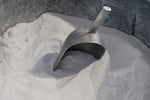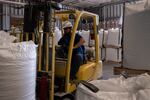
Salt deposits float as the mountains are reflected in a lithium brine evaporation pool at Silver Peak lithium mine in Silver Peak, Nev. on Oct. 6, 2022.
Bridget Bennett for NPR
Salty water gurgles quietly through a pipe across a dry lakebed and into a Caribbean-blue pond. It’s carrying an element that is crucial to the electric car revolution and, suddenly, one of the world’s hottest commodities: lithium.
Silver Peak, halfway between Reno and Las Vegas, may not resemble most people's mental image of a mine. But for decades it's been the sole domestic producer of lithium in the United States. Now the small mine is in the process of doubling its output, and facing new rivals, as part of a massive global phenomenon that's reshaping multiple industries.
Demand for electric cars is soaring and, in turn, straining supplies of lithium, which is used in the vehicles' massive batteries. Proposals for new mines abound, accompanied by controversies. One proposed site threatens the only habitat of a rare Nevadan wildflower, for example, while another has outraged both indigenous groups and ranchers. But new mines aren't the only way to get more lithium. And they're certainly not the fastest.
For the next three to five years, the world will largely be relying on already-operating mines to scale up as fast as they can, says Susan Zou, an energy metals analyst with Rystad Energy.
"Actually, in the past six months, we have been already quite surprised to see how fast those existing projects have responded to the lithium price hikes," she says.
Silver Peak shows that the race to produce more lithium isn't just happening in the future, through battles over proposed mines. It's well underway.

Lithium carbonate in the shipping warehouse at Silver Peak lithium mine in Silver Peak, Nev. on Oct. 6, 2022.
Bridget Bennett for NPR
A quiet little mine gets a new jolt of energy
Lithium can do a number of nifty tricks. As a pure metal, it bursts into flames when it touches water. In its salt form, it treats mood disorders. (It was an ingredient in the original recipe for 7 Up).
And — most significantly for the global economy — a single particle of lithium will readily shed an electron, and then zip back and forth between the positive and negative ends of a rechargeable battery, storing and discharging power as it goes.
Lithium-ion batteries are a key part of every feasible path to reducing the climate crisis. Electric vehicles can help reduce the use of gasoline and diesel. Giant batteries can store electricity from wind and solar farms to displace coal and natural gas. The batteries' promise: the quality of life that fossil fuels have provided, minus the fossil fuels themselves.
What this means for demand for minerals like lithium is almost hard to comprehend.
"We'll hit the first million [metric tons] of demand within the next few years," says Cameron Perks, a lithium expert with Benchmark Minerals Intelligence. "And then thereafter every few years adding another 1 million [metric tons] ... every few years, which is staggering."
That's an incredible pace of expansion. And it's already underway. Global lithium production has already doubled in just a few years. Now it needs to do it again. And again. And again ...

Tubes enter a lithium brine evaporation pool at Silver Peak lithium mine in Silver Peak, Nev. on Oct. 6, 2022.
Bridget Bennett for NPR
Silver Peak had been quietly supplying about 5,000 of those metric tons per year, with no expectation for any big future growth. Now it's invested some $60 million in an expansion, and is on track to make 10,000 metric tons a year by 2024.
As the name suggests, Silver Peak was once a silver mine — the kind where men tunneled into the earth to extract ore from rich veins. But more than 50 years ago, it kicked off a revolution in lithium mining by proving you could extract the mineral from liquid, not just from rock.
A lithium-rich ancient volcano sits below this dry lakebed. Workers drill down beneath the playa, pump up brine that's been soaking up that lithium, and spread it out underneath the hot sun. As water evaporates out, and salt precipitates down, the liquid that's left has a higher and higher concentration of lithium.
After at least 18 months spent journeying through 23 separate, progressively smaller evaporation ponds, the brine is pumped out and treated with a chemical that reacts with the dissolved lithium to create lithium carbonate — a white powder that's loaded into sacks weighing more than a ton each, which are shipped off to customers.
Not all of the lithium made here goes to batteries, but if it did, it could potentially meet demand for a few hundred thousand electric vehicles per year. That makes Silver Peak a relatively small player on world lithium markets; the global auto industry is already making millions of electric vehicles a year.
But as it scrambles to double its output, it's not alone. S&P Global Platts wrote in late 2021 that every major lithium producer in the world was planning an expansion.
“We’re doing everything in our power to keep up with our customers’ demand, and I know most of our competitors are, too,” says Meredith Bandy, the vice president of investor relations and sustainability at Albemarle, the company that owns Silver Peak -- as well as other, larger lithium mines around the world.
There's a very simple reason to do it, and it's not a sense of duty to help with the global fight against climate change. Lithium prices have tripled. That soaring price, combined with rising production, propelled Albemarle to record profits last quarter.

Sacks of lithium carbonate are moved in the shipping warehouse at Silver Peak lithium mine in Silver Peak, Nev. on Oct. 6, 2022.
Bridget Bennett for NPR
Looking in the laboratory and the trash heap for any spare lithium
Building new mines and boosting output at existing ones are the most obvious ways to make more lithium, but they aren't the only ways.
Albemarle is also planning to reopen a closed mine in North Carolina that used to extract lithium from rocks, and there's a shuttered mine in Quebec that's another company also plans to reopen. Reopening a closed mine, for a multitude of reasons, is an easier lift than launching one from scratch, and soaring prices make projects that were shuttered for economic reasons suddenly more profitable.
Recycling is another source of lithium, and Albemarle also intends to open a facility for recycling electric vehicle batteries. The problem is that this, much like opening a new mine, won't be a meaningful source of lithium for years. You can't recycle batteries that don't exist, and right now, a massive number of batteries to recycle simply don't yet exist.
Another avenue of research and investment — and no small shortage of hype — is the potential to use improved technology to extract lithium from the brine used at geothermal power plants. Because the brine is already being pumped, and no large evaporation ponds would be required, it promises a much smaller environmental footprint, if companies can pull it off.
"New companies coming in with new technologies may help to lower the cost of lithium extraction and unlock deposits which we never thought previously possible to unlock," Perks says.
There's actually a lot of lithium in the earth's crust. The question is whether it's feasible to extract it. And higher prices are changing that calculus every day.
For instance, U.S. Magnesium, a producer in Utah, recently started selling lithium that it had previously been accumulating as a waste product. This means Silver Peak is no longer the sole source of U.S.-produced lithium. At full capacity, U.S. Magnesium has said it could supply another 10,000 metric tons of lithium per year.
If you put on your lithium-spotting goggles, there's all kinds of potential. At Silver Peak, there's a giant hill of sand looking out over the evaporation ponds. It was dredged up from the ponds and piled up here to keep it out of the way.
"There's a theory that the salt that comes out of these ponds can also be re-harvested," says Karen Narwold, Albemarle's chief administration officer, from a perch on top of the crunchy, sparkly hill.
It's not that a salt heap at a single small mine is going to satisfy the global hunger for lithium. But the fact that it's even being considered is telling.
Yes, analysts agree that soaring demand for lithium means new mines will need to be built — which means hard conversations about where to place them and how to build them as responsibly as possible, given the substantial footprint of any mine.
But in the meantime, existing mines are trying to find out just how much lithium they can make if they go flat-out. Old mines are reopening, waste piles are getting reexamined, new technology is getting tested. Recycling operations are popping up everywhere. And, from the other end of the supply chain, battery makers are trying to figure out how to get more storage capacity from fewer raw materials.
Eying the possibility of an enormous lithium shortage, companies are placing longshot bets, and reevaluating sources once dismissed as obviously unprofitable, to try to close the gap and make a fortune in the process.
"There's something interesting about high prices," says Kwasi Ampofo, the head of minerals and mining at BloombergNEF. "It incentivizes everything."
Copyright 2022 NPR. To see more, visit https://www.npr.org.